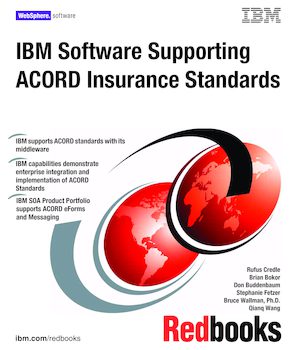IBM Software Supporting ACORD Insurance Standards
An IBM Redbooks publication
Note: This is publication is now archived. For reference only.

Published on 18 March 2009
ISBN-10: 0738432431
ISBN-13: 9780738432434
IBM Form #: SG24-7649-00
Authors: Rufus Credle, Brian Bokor, Don Buddenbaum, Stephanie Fetzer, Bruce Wallman Ph.D. and Qianq Wang
This IBM® Redbooks® publication helps you design and create demonstrations or solutions that meet ACORD insurance standards with minimal application coding. If you are not interested in creating such demonstrations yourself, we show you two and provide you with contacts to show those demonstrations.
ACORD has published and maintains insurance industry standards. The two most complete and often used standards are ACORD eForms and ACORD messaging. ACORD eForms includes hundreds of electronic forms, which can be used as-is with the IBM Lotus® Forms Viewer or modified slightly for use with the Lotus Forms Server to support straight-through processing scenarios. ACORD messaging formats can be tailored to the needs of individual insurance companies by using industry supplied tools.
This book shows you how to use IBM tools and tool content such as Lotus ACORD Forms, WebSphere® Transformation Extender ACORD Pack, and DB2® PureXML® to minimize efforts to build and maintain ACORD solutions. The solutions used in this book are available from the authors as demonstrations. This can help IBM clients understand both the value of using ACORD standards and the value of using IBM products that already incorporate these standards.
We review both developer and run-time environments. We do this to maximize the discussion potential for both open and industry standards.
The run-time environment provides a demonstration utilizing ACORD eForms (Lotus Forms) and the IBM SOA software stack to produce a seamless showcase of eForms interaction using a Workflow (BPEL) engine with Business Rules. WebSphere Business Service Fabric is also utilized to showcase how a service call can be mitigated into a business service call.
Chapter 1. Overview
Chapter 2. The development environment solution
Chapter 3. User scenarios
Chapter 4. eForms + SOA Solution architectural overview
Chapter 5. eForms + SOA Solution installation and configuration
Chapter 6. eForms + SOA Solution application installation and configuration
Appendix A. Additional material